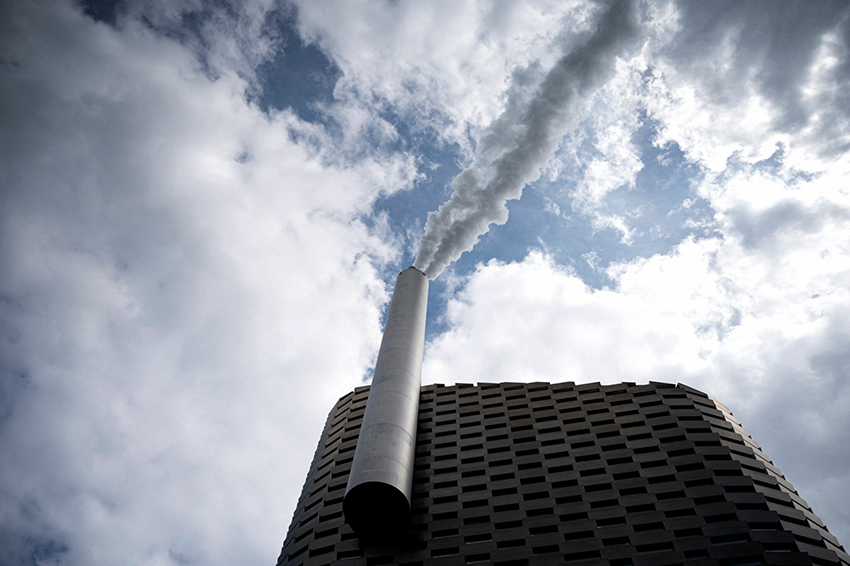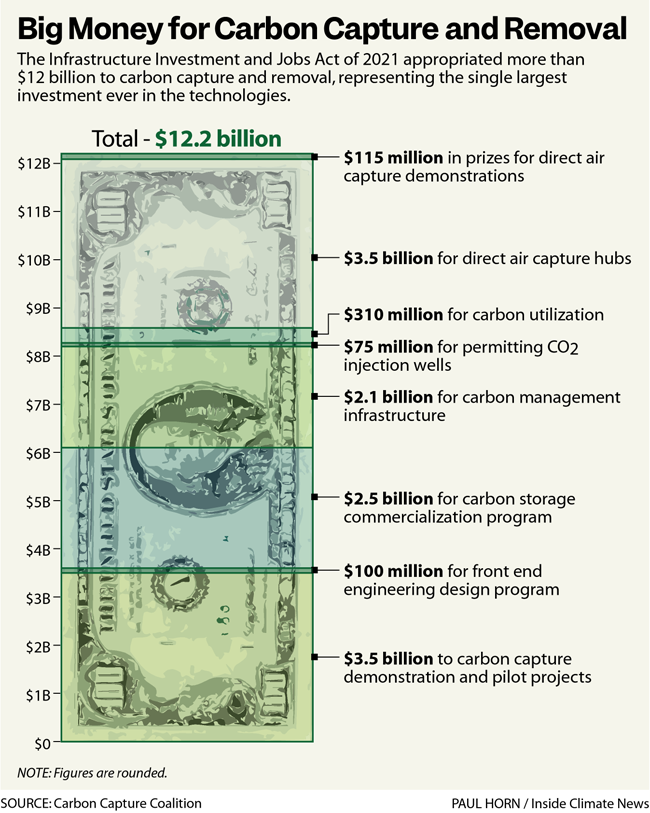
Carbon Capture Takes Center Stage,
But Is Its Promise an Illusion?
The oil industry, Biden
administration and even some environmentalists see sucking carbon
dioxide from smokestacks and the atmosphere as critical to solving the
climate crisis. But the IPCC says relying on it presents a “major
risk.”

A detail of the pilot carbon
dioxide capture plant is pictured at Amager Bakke waste incinerator in
Copenhagen on June 24, 2021. Credit: Ida Guldbaek Arentsen/Ritzau
Scanpix/AFP via Getty Images
Pipe Dreams: First of a continuing
series on whether capturing carbon is a climate solution or a
dangerous distraction.
With his climate agenda stalled in
Congress, President Joe Biden has managed to win billions in federal
spending for one pillar of his platform that is gaining increased
attention globally: carbon capture.
In a major win for oil, coal, utilities
and other industries, the federal government is poised to make its
largest investment ever—more than $12 billion from last year’s
infrastructure bill—in technologies that capture carbon dioxide from
smokestack emissions or straight from the air.
ExxonMobil, Southern Company and other
oil fossil fuel giants
have promoted carbon capture and storage as a tool for cutting
emissions for more than a decade, with little to show for it.
Still, carbon capture is gaining traction
with politicians in both parties, policy experts, scientists and even
some environmentalists who say that the threat of climate change is so
dire that it requires every possible solution.
Supporters including Sen. Sheldon
Whitehouse, a Rhode Island Democrat and one of the Senate’s most
outspoken champions of climate action, point to modeling by academics
and
others that show the technologies could play a critical role in
curbing emissions, particularly from hard-to-tackle sectors like heavy
industry and shipping.
Their arguments have won unprecedented
spending on carbon capture over the past year, with
governments in
Europe,
Canada and
Australia also committing billions in subsidies. Proponents say
all this funding could prove transformative and, within a decade,
could help cut hundreds of millions of metric tons of pollution
annually.
But many progressive climate groups like
Greenpeace and 350.org say oil companies are promoting the
technologies as a distraction to avoid phasing out their products. At
best, they argue, carbon capture and removal will play a marginal role
in limiting emissions. At worst, they warn, subsidies for the
technologies will prolong demand for fossil fuels, squandering money
that would be better spent on replacing coal, oil and gas altogether.
While the
Intergovernmental Panel on Climate Change said in 2018 that
carbon capture and removal technologies may be critical to
limiting warming to 1.5 degrees Celsius (2.7 degrees Fahrenheit),
 it also said that carbon removal in particular remains unproven
and that relying on it posed “a major risk” to meeting climate
targets. Carbon capture prevents emissions, by pulling them out of
smokestacks, while carbon removal refers to processes that suck
the gas from the atmosphere.
it also said that carbon removal in particular remains unproven
and that relying on it posed “a major risk” to meeting climate
targets. Carbon capture prevents emissions, by pulling them out of
smokestacks, while carbon removal refers to processes that suck
the gas from the atmosphere.
In 2020, U.S.
greenhouse gas emissions totalled nearly 6 billion metric tons of
carbon dioxide equivalent, including other pollutants like methane.
Even optimistic projections
say that carbon capture and removal technologies will be able to cut
only about 250 million metric tons annually by 2035, or about 4
percent of 2020 emissions.
“The Biden administration is really
doubling down on the fossil economy and the false solutions that are
entrenching that fossil economy in the name of addressing the climate
crisis,” said Carroll Muffett, chief executive of the Center for
International Environmental Law, a nonprofit advocacy group. “I think
that is a really significant failure of vision and failure of
leadership.”
The infrastructure bill, for example,
will direct billions of dollars to producing electricity and hydrogen
from fossil fuels paired with carbon capture and storage. Yet Muffett
and others point out that wind and solar are already cheaper sources
of electricity than fossil fuels, even without the added expense of
operating carbon capture equipment.
The White House declined to comment for
this article, but a spokesperson for its Council on Environmental
Quality pointed to a
report it issued last year, which said that in order to reach
net-zero emissions by mid-century, “the United States will likely have
to capture, transport, and permanently sequester significant
quantities of carbon dioxide.”

Last month, the council attempted to
square carbon capture with another pillar of Biden’s climate plan,
environmental justice,
issuing guidance that recommended including community input during
the planning and approval of all carbon capture projects.
Environmental justice advocates have been
among the harshest critics of carbon capture, saying it won’t address
the many other forms of toxic pollution from producing and burning
fossil fuels. The White House’s own Environmental Justice Advisory
Council
included carbon capture and carbon removal in a list of the kinds
of projects that would not benefit communities at all.
With the first batches of federal
spending set to start flowing this year, these competing arguments are
about to see their biggest tests yet.
A Flood of Investment
The last year has seen a wave of new
carbon capture, storage and removal projects announced, with at least
55 in the United States alone since the beginning of 2021,
according to
the Clean Air Task Force, an environmental group. Some are highly
speculative, such as a proposal by
Exxon to build a $100 billion carbon capture “hub” in the Houston
area. Exxon announced the first proposed project for the hub on
Wednesday, a plan to
attach carbon capture to its refinery complex in Baytown, Texas,
to produce low-emissions hydrogen.
The company has said the hub can proceed
only with substantial government funding and tax incentives worth $100
per ton of carbon dioxide removed, twice the current rate.
In North Dakota, an energy company bought
a coal power plant slated for closure and said
it would revive it by attaching carbon capture technology.
Other projects are further along,
particularly in sectors including ethanol and fertilizer production,
where the costs of capturing carbon dioxide are lower because of the
emissions’ high concentrations of the greenhouse gas.
In the Midwest, companies want to build a
network of carbon dioxide pipelines to connect corn ethanol plants
and distribute the gas for injection underground. These proposals are
being driven by a federal tax credit that was increased in 2018 and
gives companies up to $50 per metric ton for capturing and storing
carbon dioxide.
The Biden administration has promised its
support. Its
roadmap for reaching net-zero emissions by mid-century, released
last year, included a significant role for carbon capture and storage.
It has also said it wants to further increase the value of the carbon
capture tax credit. The
Build Back Better legislation would have raised the value to up to
$85 per ton for carbon dioxide removed from smokestacks, and up to
$180 per ton when the gas is removed directly from the air.
While the bill failed, the expanded tax
credit enjoys support from lawmakers in both parties, including
Sen.
Joe Manchin (D-W. Va.), the powerful chairman of the Energy and
Natural Resource Committee.
The promise of a bigger payout has helped
spur a wave of entrepreneurial activity and corporate investment in
carbon removal. Microsoft, Stripe, United Airlines and other companies
have announced millions of dollars in investments in carbon removal,
and some have even bought carbon offsets from the first commercial
“direct air capture” plant, which began operating last year in
Iceland. Technology giants—and billionaire executives including Bill
Gates and Jeff Bezos—have been pouring money into start-ups. Elon
Musk’s foundation is
funding a $100 million competition for efforts to pull carbon from
the atmosphere, including direct air capture, nature-based and other
approaches.
Occidental Petroleum has said it plans to
begin construction this year on a direct air capture plant in
Texas that will initially pull up to 500,000 metric tons of carbon
dioxide from the air. The company could then pump the gas into
depleted oil reservoirs to increase their production, a process that
can also store most of the carbon dioxide underground.
The
International Energy Agency last year said that the most
“cost-effective and economically productive pathway” to reaching
net-zero emissions by mid-century required not only the rapid
phase-out of coal power plants and an end to the sale of gas and
diesel cars by 2035, but also substantial amounts of carbon capture
and storage, with a more than 40-fold increase in the technology’s
capacity by 2030, to nearly 1.7 billion metric tons.
That tremendous leap would still
represent less than 5 percent of global carbon dioxide emissions in
2021. Direct air capture capacity, it said, would need to reach 90
million metric tons by 2030 from essentially zero today.
“We’re at a point when dealing with
climate that we just have to look at all the options now,” said
Shannon Heyck-Williams, senior director of climate and energy policy
for the National Wildlife Federation. Her organization is part of the
Carbon Capture Coalition, which includes fossil fuel producers,
utilities and unions and has pressed for more federal funding for the
technologies.
John Thompson is the technology and
markets director at the Clean Air Task Force, which is also a member
of the Carbon Capture Coalition, and he said that while the United
States may be closing most of its coal plants, China is building more.
Deploying the technology domestically, he said, could help China adopt
it on a larger scale.
“If our retrofits in the United States
shave five, 10 years off the time China takes to decarbonize, that’s
globally significant,” he said. “We can’t bet the planet that those
coal plants are going to close.”
Direct air capture is particularly
alluring because it could draw carbon dioxide out of the atmosphere.
Such “negative emissions” will be necessary to meet climate targets,
scientists say. Restoring natural habitats also pulls carbon from the
air, is far cheaper, and has many other benefits. But many scientists
say the capacity of that method is limited, and planting new forests
will face competing demands for land from agriculture. Storing carbon
dioxide underground could also be more durable than storing it in
trees, which are vulnerable to fires and droughts.
Supporters of pursuing direct air capture
say that, by pulling carbon dioxide from the air, the technology could
achieve something that even the most aggressive measures to avoid
emissions could not.
“Carbon removal offers a way for those of
us who have caused and benefited the most from climate change to clean
up our mess, and that’s one of the things that to me makes it
particularly attractive,” said David Morrow, director of research at
the Institute for Carbon Removal Law and Policy at American
University, though he added that direct air capture is only one of
several approaches to removing carbon dioxide from the air. “Emissions
abatement can’t do that. We can get to zero and the mess is still
there.”
Expensive and
Energy-Intensive
If these arguments sound convincing—who
wouldn’t want to lock away emissions for good?—many environmental
advocates say they gloss over an important detail. Despite decades of
research and development, and billions of dollars spent, carbon
capture and removal remain extremely expensive and energy-intensive,
even as the costs of alternatives have plummeted.
Building new renewable energy projects is
cheaper than building new fossil fuel power plants in much of the
world, and in some cases is even cheaper than continuing to operate
coal or natural gas plants. Adding hundreds of millions or billions of
dollars to build and operate a carbon capture system only worsens the
math.
A December report by the Government
Accountability Office said the Department of Energy
gave nearly $684 million to six coal plants for carbon capture
projects from 2010 through 2017, but that only one of those projects
was built and it ceased operations in 2020, citing high costs.
In the industrial sector, critics say,
other technologies such as electrification or the use of hydrogen made
with renewable electricity may be more cost effective than carbon
capture equipment.
Direct air capture is even more
expensive. The only commercial operation captures 4,000 tons of carbon
dioxide per year, an insignificant number when it comes to reducing
greenhouse gases. It was built in Iceland partly because of access to
abundant geothermal, emissions-free energy to run the project.
The technology generally requires large
amounts of power, heat or both, so scaling it would consume vast
quantities of energy and money. Skeptics argue that it would be
cheaper and better to simply feed this carbon-free energy into the
grid to electrify the economy.
Large-scale carbon capture would require
pipeline networks that would rival the scale of existing oil
pipelines. They would come with their own set of safety risks
associated with leaks and ruptures—in large volumes, carbon dioxide is
an asphyxiant.
Then there is all the other pollution
associated with producing, transporting and burning fossil fuels, much
of which would remain unaddressed by carbon capture equipment.
“That entire fossil fuel life-cycle
pollution remains in place,” said Basav Sen, climate justice project
director at the Institute for Policy Studies, a progressive think
tank. “You are in a sense losing an opportunity to deal with multiple
environmental problems in the way you tackle greenhouse gas
emissions.”
Just a Down Payment?
Carbon capture has failed to catch on
commercially—there are only a few dozen plants operating globally,
most of them in the United States. But both supporters and critics say
that might be changing, thanks largely to government support.
The funding in the infrastructure bill
was the culmination of years of lobbying by industry and unions. One
carbon capture bill, which was later included in the infrastructure
law,
drew lobbying from dozens of corporations and industry groups in
the coal, oil and power sectors, as well as from labor unions,
according to OpenSecrets, which tracks money in politics. In Exxon’s
lobbying disclosures, carbon capture and storage was the only issue
tied to the infrastructure law it reported discussing. In fact, Exxon
reported lobbying on carbon capture more than on any other issue last
year, according to an Inside Climate News analysis.
The result was more than $12 billion
dollars that will fund large scale demonstration projects to capture
and store carbon dioxide, as well as funding for the pipelines and
infrastructure that would tie it all together. The Department of
Energy, which will oversee most of the money, is required to fund at
least one demonstration project each for coal and natural gas power
plants and an industrial application. The bill directed an additional
$8 billion to “clean hydrogen” projects. Some of that funding, too, is
earmarked for using fossil fuels paired with carbon capture to produce
hydrogen. Today, hydrogen is commonly produced from natural gas, but
the process emits carbon dioxide.
Thompson, of the Clean Air Task Force,
said the funding is important to help demonstrate the technologies at
commercial scale in different applications. But he said carbon capture
will need far more government support in the form of tax incentives,
or a price on carbon emissions, to play a larger role.
“You could see enormous growth, something
like 200 million tons of CO2 captured every year in the 2030s” if the
tax incentives were increased to the levels included in the Build Back
Better Act, he said.
Put another way, $12 billion may be only
a down payment.
Reporter, New York City
Nicholas Kusnetz is a reporter
for Inside Climate News. Before joining ICN, he worked at the Center
for Public Integrity and ProPublica. His work has won numerous awards,
including from the American Association for the Advancement of Science
and the Society of American Business Editors and Writers, and has
appeared in more than a dozen publications, including The Washington
Post, Businessweek, The Nation, Fast Company and The New York Times.
You can reach Nicholas at
nicholas.kusnetz@insideclimatenews.org and securely at
nicholas.kusnetz@protonmail.com.
Green Play Ammonia™, Yielder® NFuel Energy.
Spokane, Washington. 99212
www.exactrix.com
509 995 1879 cell, Pacific.
Nathan1@greenplayammonia.com
exactrix@exactrix.com
|